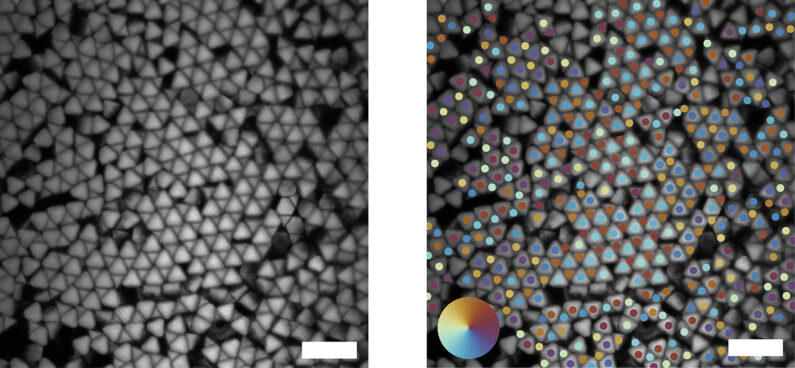Nano 3D printing is a field that continues to make steady progress, but whose applications are still being discovered. One of the most exciting areas where additive manufacturing (AM) at the nanoscale is in the creation of meta materials. At Stanford University, this frontier in nanotechnology is being explored with research led by Assistant Professor Wendy Gu. The recent study, published in Nature Communications, underscores how, with nanomaterials, the ability to change a nanoscopic shape affects the macro properties of the object being created.
“A crystal composed of nano-ball bearings will inherently differ from one made of nano-dice, leading to distinct physical properties,” Gu said in the Nature article.
Her team’s latest advancements in two-photon lithography, a form of nano 3D printing, have enabled the creation of one of the most promising geometries: Archimedean truncated tetrahedrons (ATTs). These micron-scale structures, essentially tetrahedrons with their tips removed, showcase how specific geometric patterns can result in unique material behaviors and applications.
From Theory to Tangible Reality
While the theoretical benefits of ATTs have been long discussed, actual production of these shapes has been a challenge, primarily due to their complex geometry. For this reason, Gu’s team turned to the Nanoscribe Photonic GT 3D printer. Nano 3D printing with this technology not only allows the creation of ATTs but also offers unprecedented control over their shape, enabling the assembly of materials with unique, predictable properties.

Optical images of truncated tetrahedrons forming two large hexagonal grains at an anti-phase boundary (left), and transforming into a quasi-diamond phase that initiated at the anti-phase boundary (right). Scale bars are 25 um. (Image credit: David Doan & John Kulikowski)
The research demonstrates how ATTs can self-assemble into significant structures, such as hexagonal patterns and quasi-diamond formations, the latter being of particular interest due to its potential impact on photonics and material engineering. These formations could advance various sectors by facilitating the creation of materials that can easily switch between different phases. Gu’s team is exploring how these materials could be manipulated through external stimuli such as magnetic fields, electric currents, or heat. This could lead to the development of dynamic materials capable of adapting to their environment, with applications ranging from energy-efficient solar panels to anti-fogging technology. The team aims to explore making these nanoparticles magnetic, allowing for more control over their assembly and behavior.

Confocal images of truncated tetrahedrons forming several quasi-diamond grains (left). Bond order analysis shows different quasi-diamond grains through alternating colors (right). Neighboring tetrahedrons that have alternating colors (i.e. blue and red/brown, or dark blue and yellow) indicate that they have the same grain orientation. Scale bars are 20 um. (Image credit: David Doan & John Kulikowski)
Programmable materials and the ability to switch between different crystal structures could imply applications in next-generation computer memory or other electronic components that require dynamic materials properties. Moreover, the concept of materials that can change phases with the application of external fields, like electric currents, hints at potential applications in electronic devices where control of material properties is crucial for functionality, such as sensors, transistors, or actuators.
Despite the groundbreaking nature of the research, there is still significant progress to be made in terms of commercializing applications of nanoscale 3D printing. Producing such tiny items in large number is the next step. Fortunately for these Stanford researchers, not only has Nanoscribe been advancing in this area, but so have other teams at the university. In other words, commercialization might just be around the corner.
Subscribe to Our Email Newsletter
Stay up-to-date on all the latest news from the 3D printing industry and receive information and offers from third party vendors.
You May Also Like
Gorilla Sports GE’s First 3D Printed Titanium Cast
How do you help a gorilla with a broken arm? Sounds like the start of a bad joke a zookeeper might tell, but it’s an actual dilemma recently faced by...
Nylon 3D Printed Parts Made More Functional with Coatings & Colors
Parts 3D printed from polyamide (PA, Nylon) 12 using powder bed fusion (PBF) are a mainstay in the additive manufacturing (AM) industry. While post-finishing processes have improved the porosity of...
$25M to Back Sintavia’s Largest Expansion of Metal 3D Printing Capacity Since 2019
Sintavia, the digital manufacturing company specializing in mission-critical parts for strategic sectors, announced a $25 million investment to increase its production capacity, the largest expansion to its operations since 2019....
Velo3D Initiates Public Offering in a Bid to Strengthen Financial Foundations and Drive Future Growth
Velo3D (NYSE: VLD) has been among a number of publicly traded 3D printing firms that have attempted to weather the current macroeconomic climate. After posting a challenging financial report for 2023,...































